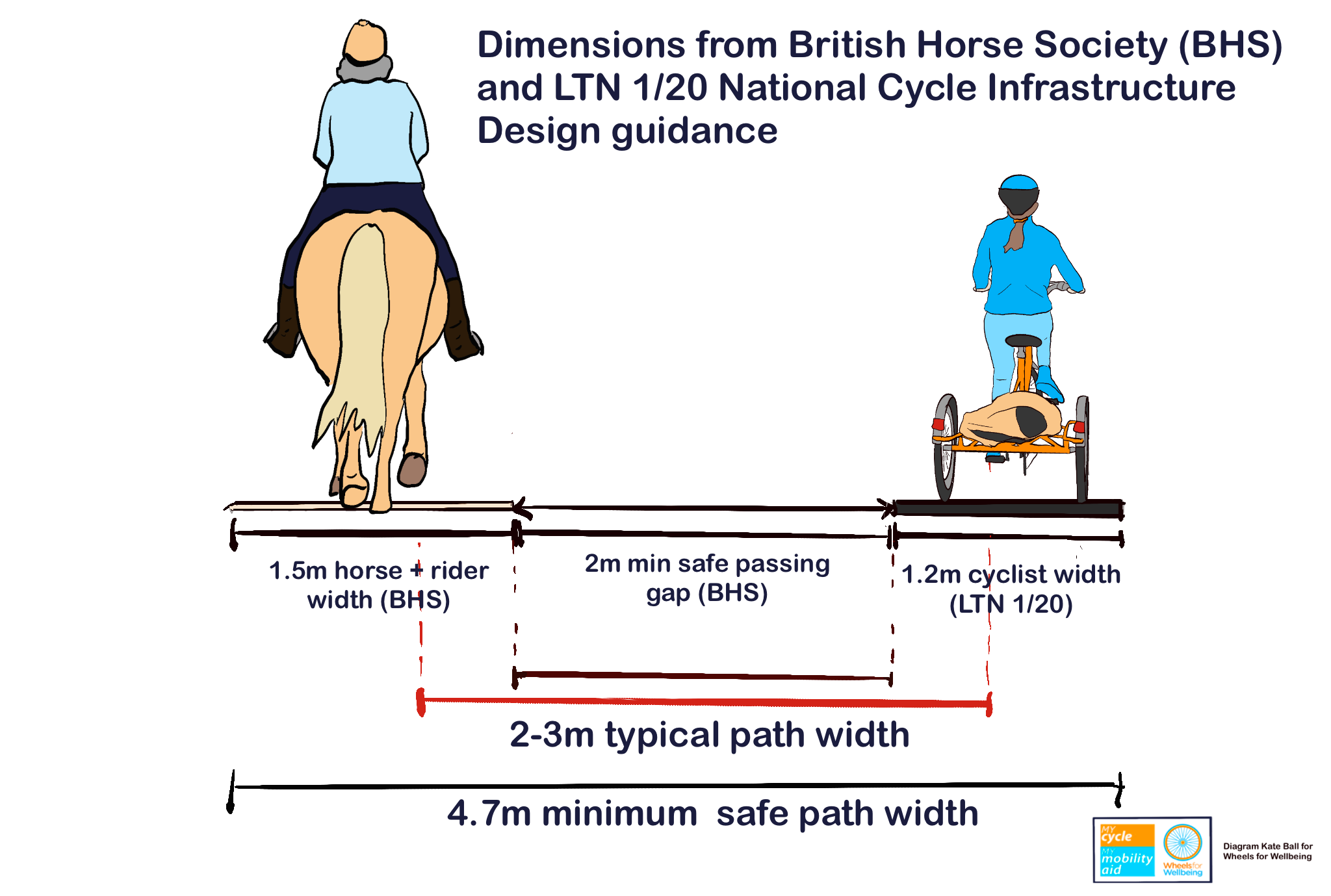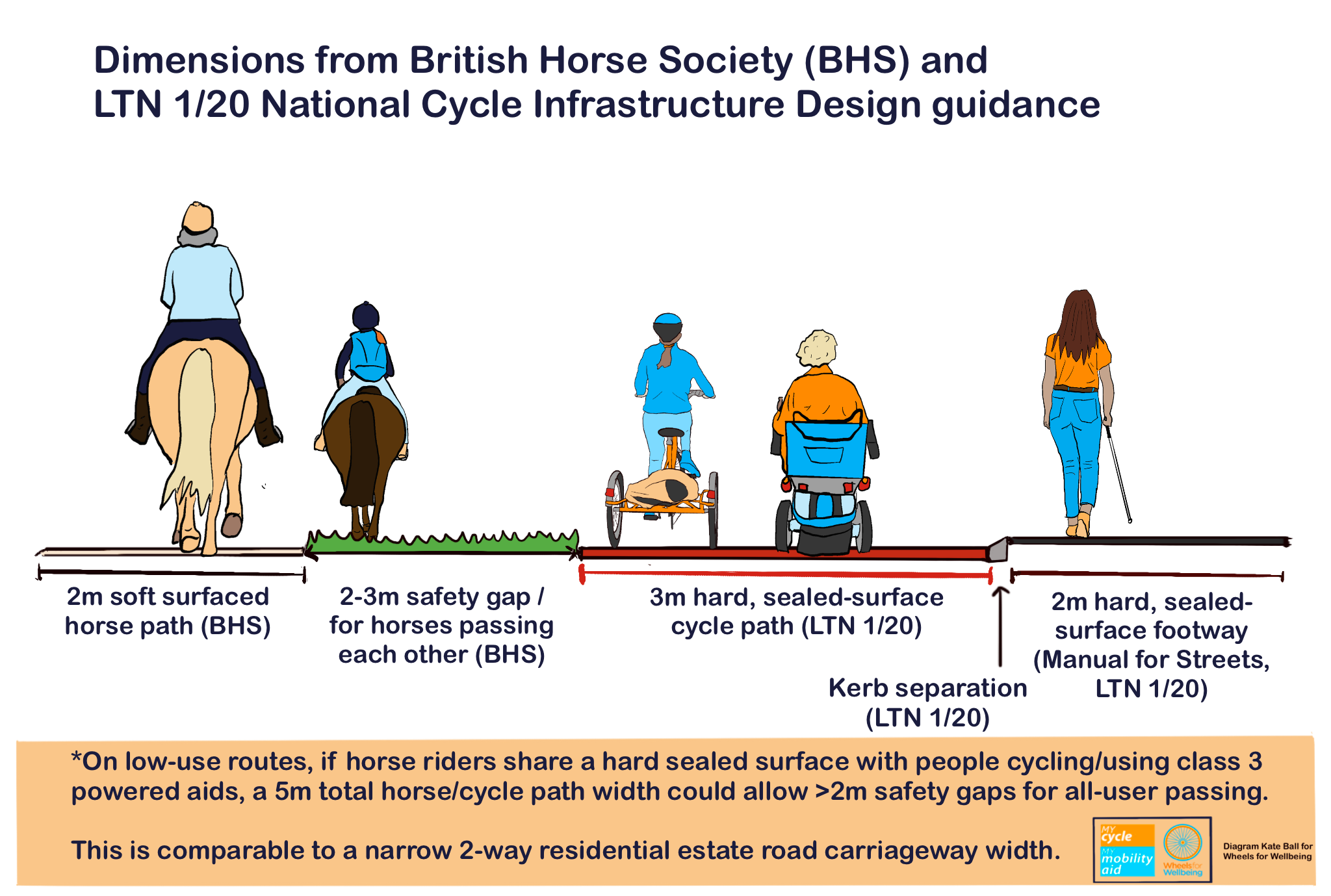Download this guide sheet in Word format
Download this guide sheet in pdf format
Walking/wheeling, cycling and horse riding:
Many Disabled people benefit from walking/wheeling, cycling, horse riding and horse driving.
This guide sets out some of the common and conflicting needs of these user groups, recognising that horses pose a significant risk to others on inadequately designed and managed routes. We hope this guidance will help ensure route designs and management are safe and accessible.
Defining active travel:
Active travel modes are those which are commonly used to complete journeys – walking/wheeling and cycling. Horse riding and horse driving are no longer practical, every-day journey modes except in a very few cases: The high cost of horse ownership or hire and practical considerations bar most people from riding. This means that horse riding, while a good leisure, exercise and therapy option for many Disabled people, is not defined as an active travel mode.
Walking/wheeling and cycling are active travel modes.
Horse riding and horse driving are not active travel modes in the UK.
Disabled active travellers and horse riders: Common access needs
Disabled and non-Disabled people walking/wheeling, cycling and riding need:
- Safety from motorised vehicles;
- Sufficient path width;
- Maintenance of vegetation for physical space and sight lines. However, maintenance needs for different modes are different: Disabled people walking/wheeling and cycling need better maintenance of path surfaces and widths than horse riders, while horse riders need greater clear path heights.
Disabled active travellers and horse riders: Conflicting needs or preferences
- Surfaces: BHS recommends natural and/or softer surfaces, whereas Disabled people walking/wheeling and cycling need inflexible, sealed surfaces: LTN 1/202.18 states “Unbound surfaces are generally unsuitable for utility cycling and in practice have proven to require regular maintenance and repair, being prone to erosion on gradients and easily damaged by horses”. New recycled rubber surfaces are also inadequately accessible even when in good condition, as well as having onerous maintenance requirements. They are prone to rapid deterioration, including potential serious damage when exposed to fire, as indicated by flame testing of other comparable products. We disagree with BHS guidance that bound rubber surfaces are as accessible for wheeled users as asphalt and recommend machine laid asphalt as best practice surfacing for walking/wheeling and cycling.
- Horses pose a significant hazard to other path users – especially to Disabled users who are less likely to be able to move out of the way of a skittish horse, and may be using mobility aids or moving in ways which may startle some horses.
- Requirement for all path users to give horses large amounts of space and time – this is not feasible on many utility routes or routes with significant horse/active travel use, particularly for Disabled people, who may be unable to see or communicate with riders, be less able to move out of the way, or be using wide mobility aids (see details below).
- Infrastructure: The needs of horse riders for path evenness, gradients, turns, access restriction barriers (often gates, cattle grids and step-overs) and maintenance are very different from Disabled users: Routes which are accessible to horse riders are frequently not accessible to Disabled people walking/wheeling and cycling.
Equality Act (2010): Disabled route users have protected characteristics in law, including the right to equal access to public spaces with non-Disabled people. Horse riders or equestrians do not have the right to access public spaces by default.
Mitigating and designing out conflicts
British Horse Society (BHS) advice recommends people walking/wheeling, (running) and cycling pass horses with at least a car’s width gap, 6-8ft (2-3m) minimum, to reduce risk of being kicked. Their guidance recommends people walking/wheeling and cycling give a rider plenty of notice of passing, passing slowly and stopping if a rider wants you to, and avoiding passing at narrower points. This may be reasonable on very quiet, largely recreational-use paths, but is self-evidently not feasible on busier routes where people are making necessary active travel journeys.
A horse and rider will take up 1-1.5m width, with BHS recommending 3m minimum for two horse riders to pass. A person cycling or walking/wheeling also needs at least 1.2m width – so for a safe passing gap, an absolute minimum 4.7m path width is needed. Few existing or planned traffic-free routes have widths over 3m. Many existing paths have 2-3m maximum widths, and some have functional clear widths at surface level of 1m or less, especially if poorly maintained.
This means that on most existing paths and many planned new paths, situations where horse riders need to pass other path users will be inherently dangerous to the non-horse-riding path user, unless unusually wide paths of 5m+ width or regular safe passing places are created:
5m is a similar width to a narrow residential estate road, excluding the footways. Including just a single, minimum-width protected footway will require a minimum total path width of 7m.
Therefore, in locations where high cycle and/or pedestrian flows are anticipated and where horse rider access is considered necessary or desirable, we recommend that scheme leads and designers ensure all stakeholders understand and agree to the absolute minimum safe path specifications which will be required.
Implications of BHS and LTN 1/20 guidance for minimum safe path widths for paths shared between people walking/wheeling and cycling and horse riders

Parallel paths
Where only short sections of routes or specific crossing locations are likely to have significant equine traffic, it may be feasible to alter just these sections by widening surfaces or providing parallel paths.
In line with BHS guidance, we recommend that routes designated as bridleways or restricted byways that are intended as part of active travel networks for utility journeys should ideally have horse traffic accommodated on separate, protected, suitably-surfaced paths. People walking and wheeling should, following Inclusive Mobility (2022) and LTN 1/20, have separate provision from those cycling. This will enable safe and efficient movement of active travellers while enabling comfortable use of the route by equestrians.
We recommend that routes should only be designated as bridleways or restricted byways where there is space to provide suitable, safe provision for all legitimate path users.
Implications of BHS and LTN 1/20 path surfacing guidance and minimum safe passing space guidance for parallel path design widths

Route designation options
Routes can be designated as:
- Footpaths, open to walking/wheeling. Good accessibility practice for public routes is in BS8300 and Inclusive Mobility (2022). For low-use rural footpaths, BS5709 and Outdoor Accessibility Guidance (2022) may be appropriate, ensuring that route widths remain at or above the minimum 1.2m in Inclusive Mobility.
- Cycle tracks, open to walking/wheeling and cycling, but not to horse riders. Please see our My Cycle, My Mobility Aid campaign for more information on our position that class 3 mobility scooter and powerchair users should be legally permitted to use cycleways and cycle lanes at 8mph.
- Bridleways, open to walking/wheeling, cycling and horse riders, unless a specific restriction is enacted to prohibit cycling.
- Restricted Byways, generally open to walking/wheeling, cycling, horse riders and horse drawn vehicles.
We understand that it may be simpler in some cases to designate a route a bridleway than a cycle track. However, we call on decision makers and designers to undertake full Equality Impact Assessments (EQAs or EqIAs) to consider whether the route will be safe and accessible for Disabled people walking/wheeling and cycling if they have to share space with horse riders, including whether there is sufficient space for all users to pass each other safely, then to designate routes accordingly.
Restricted access times for horse riding (and non-Disabled cycling)
Some leisure routes which become busy in summer, at weekends and during holidays may be sufficiently quiet to allow safe use by horse riders during winter and outside popular times.
In some places it may be appropriate to restrict access to walking/wheeling users only (including Disabled people using cycles as mobility aids at walking speed) at busy times.
Designated hours of use for equestrians would also enable Disabled people to choose outing times where they will not have to share space with horse riders. This would be similar to schemes used to restrict horse access to beaches at busy times, for example in Swansea.
Education and signage
Clear signage should be used to indicate which modes may use any given route. Where horse riders (and horse-drawn vehicles) are permitted to use a route, provide signage with information on safe passing practices for all route users, ensuring that all path users have the opportunity to be educated about the risks they may pose to others.
Education is important to ensure that local riders, particularly teens learning to hack out alone, are able to ride safely near other path users, including Disabled people.
Highway Code rules 47 to 55 are for horse riders and horse drivers.
Rule 54: “You MUST NOT take a horse onto a footpath or pavement, and you should not take a horse onto a cycle track”
Cyclists, especially those riding in clubs and fast commuters, also need to be educated in how to use traffic-free routes safely – and to use roads where they want to cycle in ways that are not compatible with safe walking/wheeling, cycling and horse riding for everyone else.
Highway Code rules 59 to 82 are for cyclists.
Rule 63: “When riding in places where sharing with pedestrians, horse riders or horse drawn vehicles is permitted, take care when passing pedestrians and horse riders, especially children, older adults or disabled people.”
Rule 64: “You MUST NOT cycle on a pavement”
We encourage enforcement to reduce risk to path users from illegal motorcycle use, including illegal e-motorcycles. All legal e-cycles have motors which cut out at or below 15.5mph.
